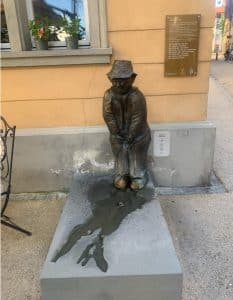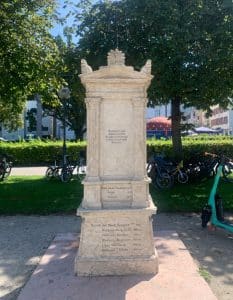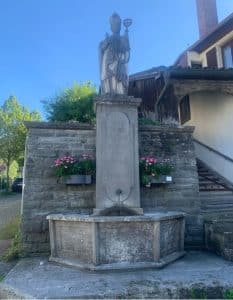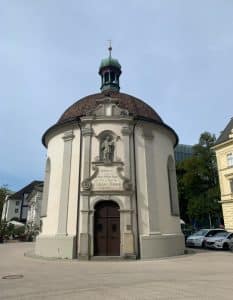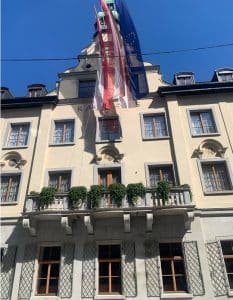Bregenz, a charming city located on the eastern shores of Lake Constance in Austria, offers an intriguing blend of ancient history and modern culture. One of the most significant historic landmarks that bear testament to its rich past is the Lower City Gate, also known as “Unteres Tor” or “Seetor”. This monumental gate serves as the main entrance to Bregenz’s old town.
Historical Significance
The Lower City Gate has been a prominent part of Bregenz’s townscape for centuries. It was originally constructed during the Middle Ages when it served as one of two primary entrances into this fortified city. The other gate, now lost to time, was called Upper Gate (“Oberes Tor”). Together these gates were integral parts of Bregenz’s defense system against invaders.
The architecture reflects its historical significance with its imposing structure standing tall amidst modern buildings. Despite several renovations over centuries due to wars and natural calamities, it still retains some original features such as stone masonry work which showcases medieval craftsmanship at its best.
Architecture and Design
The Lower City Gate is characterized by robust construction typical for military fortifications from medieval times. Built entirely out of durable local stone materials, it presents an impressive sight with its high walls topped by crenelations – a detail characteristic for defensive structures aimed at protecting archers and crossbowmen stationed on top.
An interesting feature about this architectural marvel lies in how it integrates seamlessly into surrounding houses forming a continuous line along Seestraße (Lake Street). This integration not only enhances aesthetic appeal but also provides extra stability ensuring longevity despite harsh weather conditions common in this region.
A Walk through History
Taking a stroll through the Lower City Gate transports you back in time when knights roamed these streets and the city was a bustling center of trade. As you walk under its arch, look up to see the beautifully preserved wooden beams support structure – an authentic piece of medieval architecture.
On either side of the gate, you will find narrow alleyways leading into Bregenz’s old town. These quaint lanes are lined with traditional Austrian houses showcasing unique architectural styles dating back to different periods in history. Exploring these alleys is like walking through a living museum offering glimpses into everyday life from centuries ago.
The Surrounding Area
Beyond just being an impressive historical monument, Lower City Gate also serves as a perfect starting point for exploring Bregenz’s old town. Just steps away from this iconic gateway lie numerous attractions including Martins Tower (Martinsturm), one of Austria’s oldest surviving medieval towers; Gothic Parish Church (Pfarrkirche); and Landhaus, home to Vorarlberg provincial government since 1523.
Nearby Lake Constance offers stunning views and myriad recreational activities such as boating, swimming or simply relaxing on its shores enjoying serene beauty around. A visit during summer months brings opportunity to witness famous Bregenzer Festspiele – an annual performing arts festival held on floating stage over lake waters!
Visiting Information
The Lower City Gate is located at Seestraße in downtown area easily accessible by public transportation or foot if staying nearby. It remains open throughout year welcoming visitors without any entry fee making it ideal destination for budget travelers interested in history and architecture.
In conclusion, whether you’re a history buff eager to explore ancient fortifications or someone who appreciates fine architecture, Lower City Gate in Bregenz promises an unforgettable experience transporting you back into Middle Ages while allowing appreciation for how far we have come since then!
Frequently asked questions
What is the significance of the Lower City Gate in Bregenz?
The Lower City Gate, also known as Untertor, holds significant historical importance for Bregenz. It’s one of the few remaining medieval fortifications and served as a crucial entrance to the old town. Its existence dates back to around 1250 AD when it was built during a period of expansion in Bregenz. The gate not only symbolizes the rich history and heritage of this Austrian city but also provides an intriguing insight into its architectural evolution over centuries.
Where exactly is Lower City Gate located?
The Lower City Gate is situated at Kirchstraße 6, 6900 Bregenz, Austria. It’s nestled within the charming old town region (Oberstadt) which sits on a hill overlooking Lake Constance (Bodensee). This location makes it easily accessible from various parts of Bregenz and offers visitors stunning views across the lake and surrounding landscapes.
What are some nearby attractions I can visit after exploring Lower City Gate?
Besides visiting the historic Lower City Gate itself, there are several other attractions within walking distance that you might want to explore. These include prominent landmarks such as Martinsturm (St Martin’s Tower), Herz-Jesu-Kirche (Sacred Heart Church), Vorarlberg Museum, Kunsthaus Bregenz art museum and Pfänder Mountain with its panoramic cable car ride. Additionally, you can enjoy leisurely strolls along Lake Constance or indulge in local cuisine at numerous cafes and restaurants scattered throughout old town.
Can I take guided tours around or inside Lower City Gate?
No specific guided tours are available for just the lower city gate due to its smaller size compared to other attractions in Bregenz. However, the city does offer general guided tours that cover a range of historical sites including this gate. These tours provide an excellent opportunity to learn more about Bregenz’s history and architecture from knowledgeable local guides.
What is the best time to visit Lower City Gate?
The Lower City Gate can be visited all year round as it’s an outdoor monument. That said, spring and summer are generally considered the best times for sightseeing in Bregenz due to pleasant weather conditions. During these seasons, you’ll also have better chances of enjoying other outdoor activities around Lake Constance or hiking up Pfänder Mountain.




